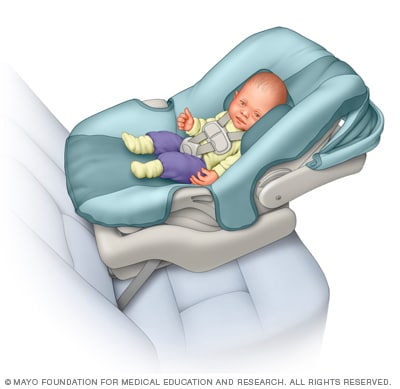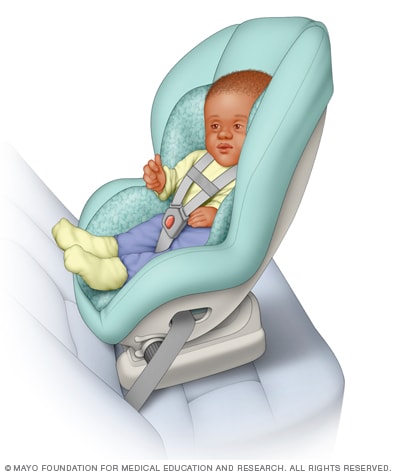Car seat safety: Avoid 9 common mistakes
Car seat safety isn't child's play. Learn about nine common mistakes parents make when they install and use car seats.
By Mayo Clinic Staff
Knowing how to safely buckle up your child as they grow can seem tricky. Check out nine common mistakes parents often make when it comes to car seat safety. Then learn the right ways to keep your child safe on the road.
1. Getting a used car seat without doing your homework
If you're thinking about buying a used car seat for your child, make sure the car seat:
- Comes with instructions.
- Also comes with a label that shows the date the car seat was made and its model number.
- Hasn't been recalled by the seat maker for flaws, safety concerns or other issues.
- Isn't expired or more than six years old.
- Doesn't look like it's damaged or has missing parts.
- Has never been in a crash.
If you don't know the car seat's history, don't use it.
2. Placing the car seat in the wrong spot
The safest place for your child's car seat is in the back seat, away from active air bags. Air bags in the front seat are made to protect the head and face of an adult-sized person in a seat belt. If you place the car seat in the front seat and the air bag inflates, it can be dangerous. It can cause a serious or fatal injury if the airbag inflates and hits the seat or child.
Some vehicles have only one row of seats, such as some pickup trucks. Don't use a car seat in these unless you can turn off the air bag.
If you place only one car seat in the back seat, install it in the center of the seats. Just make sure it can fit well there. Placing the car seat in the center lowers the risk of injury during a crash.
3. Installing the car seat or buckling up your child the wrong way
Illustration of an infant-only car seat
Illustration of an infant-only car seat

Illustration of an infant-only car seat
Infant-only car seats usually have a handle for carrying. They can be snapped in and out of a base that's installed in a vehicle.
Illustration of a convertible car seat
Illustration of a convertible car seat

Illustration of a convertible car seat
Convertible car seats can be used rear or forward facing. They typically have higher rear-facing height and weight limits than do infant-only car seats.
Before you install a car seat, read the seat maker's instructions. Also read the section on car seats in your car's guidebook. Make sure the seat is tightly secured. To check, grab the bottom of the seat near the attachment points. If you can move the seat more than 1 inch (2.5 centimeters) from side to side or front to back, that means it's not secured tightly enough. Also make sure that the seat faces the correct way.
If you use a seat that's only for infants or a convertible seat that faces the back of the car, keep these tips in mind:
- Use the harness slots described in the car seat's instruction guide. The slots are usually located at or below the child's shoulders. Place the harness straps over your child's shoulders.
- Buckle the harness straps and chest clip. Make sure it's a snug fit. The chest clip should be even with your child's armpits. Make sure the straps and clip lie flat against your child's chest and over their hips with no slack. If you need to, place tightly rolled small blankets alongside your baby for head and neck support. If the car seat maker allows, place a rolled washcloth between the crotch strap and your baby to make a safer fit.
4. Reclining your child at the wrong angle
If your child's car seat faces the rear of the car, follow the seat maker's instructions to recline the seat. Do this so your child's head doesn't flop forward. Babies must ride semi-reclined to keep their airways open. Many seats include parts that let you change how much the seat reclines. Many also include a device that helps you find the correct angle to recline the seat at. As your child grows, you might need to change the angle. Check the seat maker's instructions for details.
5. Moving to a forward-facing car seat too soon
Parents often want to see their child's face in the rearview mirror. That means they might want to turn the car seat forward facing before it's recommended. But riding rear facing for as long as possible is the safest option. It's suggested until a child reaches the highest weight or height allowed by the car seat maker. You can start with a convertible seat. It can be used rear facing and, later, forward facing. It typically has a higher rear-facing weight and height limit than does an infant-only seat. Or you can switch from an infant-only seat to a convertible car seat as your baby grows.
When your child reaches the weight or height limit of the convertible seat, you can face the seat forward. When you make the switch:
- Install the car seat in the back seat according to the seat maker's instructions. Use either the seat belt or Lower Anchors and Tethers for Children (LATCH) system.
- Use the tether strap to keep the seat extra stable. It's a strap that hooks to the top of the seat and attaches to an anchor in the car.
- Adjust the harness straps so that they're at or above your child's shoulder level. Make sure they fit snugly.
6. Not removing your child's heavy outer clothes
Bulky outer layers of clothes and blankets can prevent harness straps from snugly securing your child. There's a safer way to keep your baby warm. Buckle the harness. Then place a coat or blanket over the harness.
7. Moving to a booster seat too soon
Older children need booster seats to help an adult seat belt fit right. You can switch from a car seat to a booster seat when your child has topped the highest weight or height that the car seat maker allows. It's important to learn your state's booster seat laws, too. Different states have different laws about how old a child must be before they can stop using a booster seat. Don't forget, though: Your child is safest when they stay in a car seat with a harness for as long as possible.
8. Using a booster seat the wrong way
You need to use booster seats with a lap and shoulder belt — never a lap-only belt. Make sure the lap belt lies low across your child's thighs. Also make sure the shoulder belt crosses the middle of your child's chest and shoulder.
9. Switching to a seat belt too soon
Most kids can safely use an adult seat belt sometime between ages 8 and 12. Here's how you'll know that your child is ready:
- Your child reaches a height of 4 feet 9 inches. That's nearly 1.5 meters.
- Your child sits against the back of the seat with their knees bent comfortably at the edge of the seat.
- The lap belt lies low across your child's upper thighs — not the stomach. The shoulder belt rests on the middle of your child's chest and shoulder — not on the neck or face.
Keep in mind that the back seat is the safest place for children younger than age 13.
It can be a good idea take part in a local car seat clinic or inspection event. These can be helpful if you have questions about child passenger safety laws or if you need help installing a car seat. You can also check with the National Highway Traffic Safety Administration for help finding a car seat inspection station.
May 23, 2023
- Durbin DR, et al. American Academy of Pediatrics Committee on Injury, Violence, and Poison Prevention. Policy statement — Child passenger safety. Pediatrics. 2018; doi:10.1542/peds.2018-2460.
- Durbin DR, et al. American Academy of Pediatrics Committee on Injury, Violence, and Poison Prevention. Technical report — Child passenger safety. Pediatrics. 2018; doi:10.1542/peds.2018-2461.
- Car seat recommendations for children. National Highway Traffic Safety Administration. https://www.nhtsa.gov/equipment/car-seats-and-booster-seats#age-size-rec. Accessed Sept. 17, 2020.
- Child passenger safety. Centers for Disease Control and Prevention. https://www.cdc.gov/features/passengersafety/. Accessed Sept. 17, 2020.
- How to install a rear-facing only infant car seat. National Highway Traffic Safety Administration. https://www.nhtsa.gov/car-seats-and-booster-seats/how-install-rear-facing-only-infant-car-seat. Accessed Sept. 17, 2020.
- Altman T, et al., eds. Keeping your child safe. In: Caring for Your Baby and Young Child: Birth to Age 5. 7th ed. Bantam Books; 2019.
- Used Car Seat Safety Checklist. National Highway Traffic Safety Administration. https://www.nhtsa.gov/car-seats-and-booster-seats/used-car-seat-safety-checklist. Accessed Nov. 1, 2022.
- Booster Seat Planning Guide. Centers for Disease Control and Prevention. https://www.cdc.gov/transportationsafety/pdf/Booster-Seat-Guide_508c.pdf. Accessed Nov. 1, 2022.